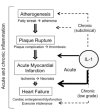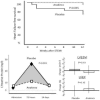Targeting interleukin-1 in heart disease
- PMID: 24146121
- PMCID: PMC3938092
- DOI: 10.1161/CIRCULATIONAHA.113.003199
Targeting interleukin-1 in heart disease
Keywords: heart diseases; inflammation; interleukins.
Conflict of interest statement
Figures






Comment in
-
Letter by Takahashi regarding article "targeting interleukin-1 in heart disease".Circulation. 2014 Aug 12;130(7):e62. doi: 10.1161/CIRCULATIONAHA.114.008658. Circulation. 2014. PMID: 25114192 No abstract available.
-
Response to letter regarding article, "targeting interleukin-1 in heart disease".Circulation. 2014 Aug 12;130(7):e63. doi: 10.1161/CIRCULATIONAHA.114.010274. Circulation. 2014. PMID: 25114193 No abstract available.
References
-
- Doria A, Zen M, Bettio S, Gatto M, Bassi N, Nalotto L, Ghirardello A, Iaccarino L, Punzi L. Autoinflammation and autoimmunity: bridging the divide. Autoimmun Rev. 2012;12:22–30. - PubMed
-
- Medzhitov R, Janeway CA., Jr Decoding the patterns of self and nonself by the innate immune system. Science. 2002;296:298–300. - PubMed
Publication types
MeSH terms
Substances
Grants and funding
LinkOut - more resources
Full Text Sources
Other Literature Sources
Medical

